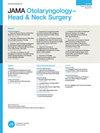Reconstruction of the mastoidectized ear.
引用次数: 4
Abstract
Moderator Dr. Tabb: We will concentrate on the modified radical mastoidectomy and the radical mastoidectomy where the posterior osseous canal wall is removed and a mastoid cavity created. Radical mastoid operations are usually performed for chronic infections and/or cholesteatomas involving the middle ear and mastoid process of the temporal bone. The first objective of the mastoid surgeon should be eradication of the disease. We would naturally assume that this has been accomplished before any reconstructive surgery is performed. In achieving the goal of disease removal, it is inevitable in some cases that varying amounts of the posterior osseous canal wall must be removed, creating a mastoid cavity, which, in the opinion of many otologists, is a deformity and should be reconstructed. I would like to start off with a question: Why should we attempt to reconstruct the bony canal wall? Why should we attempt to avoid a mastoid cavity? Dr.乳突化耳的重建。
主持人Dr. Tabb:我们将集中于改良的根治性乳突切除术和根治性乳突切除术,根治性乳突切除术切除后骨管壁并形成乳突腔。根治性乳突手术通常用于累及中耳和颞骨乳突的慢性感染和/或胆脂瘤。乳突外科医生的首要目标应该是根除这种疾病。我们会很自然地认为在进行任何重建手术之前这已经完成了。为了达到去除疾病的目的,在某些情况下不可避免地必须去除不同数量的后骨管壁,形成乳突腔,在许多耳科医生看来,乳突腔是畸形的,应该重建。我想从一个问题开始:为什么我们要尝试重建骨管壁?为什么我们要避免乳突腔?博士。
本文章由计算机程序翻译,如有差异,请以英文原文为准。
求助全文
约1分钟内获得全文
求助全文

 求助内容:
求助内容: 应助结果提醒方式:
应助结果提醒方式:


